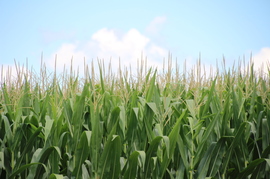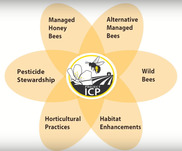|
|
|
Fresh from the Field is a weekly album showcasing transformative impacts made by grantees supported by the National Institute of Food and Agriculture.
Nov.
9, 2017
|
|
Success Stories of the Week
 New App Makes it Easier for Farmers to Identify, Manage Corn Ear Rots, Mycotoxins
Current tools make it impossible for U.S. corn growers to guarantee that their crop will contain acceptable levels of mycotoxins, such as aflatoxins and fumonisins. Corn ear rots occur when certain fungi infect corn. Several of those fungi produce mycotoxins, which can be harmful to livestock and humans if contaminated grain is used in livestock feed or human food products.
A new mobile app developed by researchers from Purdue University and the University of Arkansas will make it easier for farmers to access information about corn ear rot and mycotoxins.
The app, available as a free download, helps users identify common ear rots and determine safe levels for the use of grain affected by mycotoxins. The app also has information on ear rot management and properly storing moldy grain. Resources include practical tips for ear rot management and in-depth information on mycotoxins and conditions that favor ear rot development.
NIFA supported this project through an Agriculture and Food Research Initiative grant.
Read the full article at Press Release Point. USDA photo.
|
 'Virtual Farm' Website Provides a Plethora of Dairy Sustainability Information
Changing weather patterns pose significant challenges for modern dairy farmers — excessive hot or cold temperatures, drought, and humidity can have a detrimental effect on cows' health, which ultimately can lead to decreased milk production.
Deciding how best to react to those changes to ensure the vitality of dairy farms can present a bit of a conundrum. Now, those farmers can see sustainability principles in action with just a few mouse clicks, thanks to an interactive "virtual farm website" developed by researchers in Penn State's College of Agricultural Sciences and Penn State Extension, in partnership with the project's lead, the University of Wisconsin-Madison, Cornell University, and the Dairy Innovation Center.
The catalyst for developing the virtual farm was a growing movement in the dairy industry to adopt practices that mitigate the negative effects of agricultural operations on the environment, while securing the future sustainability of farms.
NIFA supported this project with an Agriculture and Food Research Initiative grant.
Read more about this research in Penn State News. Image by Eileen Fabian.
|
News Coverage
 Improving Ethylene Inhibitors to Increase Self Life
Each year in the United States, over $30 billion in produce goes to waste due to spoilage. Less waste means that growers and shippers of produce end up with more dollars in their pocket, and that nutritious and high quality produce can make it to the consumer at a more affordable price. In many types of produce, spoilage is driven by ethylene gas, a hormone that plants release in response to aging or stress.
Ethylene inhibitors have been used to slow the effects of ethylene aging. Hazel Technologies, in Skokie, Illinois, is taking industrial-level application and downsizing it to a continuous application method at the box level. This application across a much wider range of commodity types means that ethylene protection can follow produce through the supply chain and reduce spoilage.
NIFA supports this project with a Small Business Innovation Research Phase II grant.
Read the full article at the Fruit Growers News. Image courtesy of the National Sustainable Agriculture Coalition.
|
The Library
 60,000 Have Been Impacted by Beginning Farmer Programs
A new report, "Cultivating the Next Generation," examines the impact of USDA’s Beginning Farmer and Rancher Development Program (BFRDP), the only federal program explicitly dedicated to training the next generation of farmers.
BFRDP has had many successes over the last decade. The program is helping to grow the next generation of farmers, building up agricultural infrastructure, and continues to innovate new ways to support entrepreneurship through farmer training projects. Since 2008, BFRDP has invested roughly $150 million in more than 250 new farmer training projects across the country.
Key report findings include: More than 60,000 beginning farmers have been impacted directly by BFRDP projects; almost all projects focused on farmers in their first five years of farming, with a significant focus on those farmers starting out at a small-scale; and more than half of all projects served socially disadvantaged farmers as their primary audience.
NIFA partnered with the National Sustainable Agriculture Coalition to conduct the first-ever comprehensive evaluation of BFRDP. Advisory Team members include: the University of California-Berkeley, Center for Rural Affairs, CROPP Cooperative, Land for Good, Land Stewardship Project, and the National Young Farmers Coalition.
NIFA supports BFRDP, with at least 5% of grant funds dedicated to helping veterans.
Read the full article at the Indiana Prairie Farmer. Image courtesy of the National Sustainable Agriculture Coalition.
|
Video
 Integrating Pollination to Improve Agricultural Production and Pollinator Health
Insect pollination accounts for about one-third of our diets, and $15-18 billion per year to the U.S. agriculture industry. However, there have been declines in overall pollinator populations in the past several years. The Integrated Crop Pollination Project, a multi-state partnership of 16 institutions led by Michigan State University, is investigating different pollination strategies in various fruit and vegetable crops.
NIFA supports ICP through a Specialty Crop Research Initiative grant.
Watch the "What is Integrated Crop Pollination?" video.
|
Tweet of the Week
#NIFAIMPACTS
|
|

For more NIFA Impacts, visit nifa.usda.gov/impacts or the Land-Grant University Impacts website. Send us your NIFA-funded impacts at impactstories@nifa.usda.gov or share them with USDA_NIFA on Twitter #NIFAimpacts.
NIFA’s mission is to invest in and advance agricultural research, education, and extension to solve societal challenges. NIFA’s investments in transformative science directly support the long-term prosperity and global preeminence of U.S. agriculture.
USDA is an equal opportunity lender, provider, and employer.
Fresh from the Field is a weekly compendium of news and information that may be of interest to land-grant and non-land-grant universities, NIFA stakeholders, and other subscribers.
Editor: Falita Liles; Co Editor: Scott Elliott
|
|